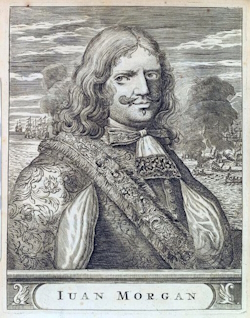 Although Henry Morgan is often called a pirate, he was really more of a privateer and soldier, only attacking the Spanish and usually not without a commission. At lot of information about Morgan comes from Alexander Exquemelin, who sailed with him as a surgeon. Most of this information was not very flattering, generally portraying the buccaneer leader in a negative light and accusing him of deeds that were not necessarily true. Among other things, Exquemelin claimed that Morgan was born poor and became an indentured servant in the Caribbean, but he in fact he more likely came from a family of wealthy Welsh farmers. One of his uncles, Edward Morgan, was even Lieutenant Governor of Jamaica. He was born Harri Morgan in about 1635 in either Llanrumney or Pencarn in the then Welsh county of Monmouthshire. His name was first anglicised to Henry when he was knighted in 1674. However, not much else is known about his early life. It is thought he first arrived in the Caribbean at the age of twenty as part of the invasion force sent by Cromwell to capture Hispaniola and/or was a part of a raiding force of privateers led by Sir Christopher Myngs during the Anglo-Spanish war of 1654-1660, which continued until as late as 1671 in the Caribbean. He fought alongside Myngs, attacking Spanish settlements such as Santiago and Campeche, possibly captaining one of the vessels. Morgan was a charismatic and tactical genius throughout his privateering career, but suffered from a weakness for drink and gambling.
Although Henry Morgan is often called a pirate, he was really more of a privateer and soldier, only attacking the Spanish and usually not without a commission. At lot of information about Morgan comes from Alexander Exquemelin, who sailed with him as a surgeon. Most of this information was not very flattering, generally portraying the buccaneer leader in a negative light and accusing him of deeds that were not necessarily true. Among other things, Exquemelin claimed that Morgan was born poor and became an indentured servant in the Caribbean, but he in fact he more likely came from a family of wealthy Welsh farmers. One of his uncles, Edward Morgan, was even Lieutenant Governor of Jamaica. He was born Harri Morgan in about 1635 in either Llanrumney or Pencarn in the then Welsh county of Monmouthshire. His name was first anglicised to Henry when he was knighted in 1674. However, not much else is known about his early life. It is thought he first arrived in the Caribbean at the age of twenty as part of the invasion force sent by Cromwell to capture Hispaniola and/or was a part of a raiding force of privateers led by Sir Christopher Myngs during the Anglo-Spanish war of 1654-1660, which continued until as late as 1671 in the Caribbean. He fought alongside Myngs, attacking Spanish settlements such as Santiago and Campeche, possibly captaining one of the vessels. Morgan was a charismatic and tactical genius throughout his privateering career, but suffered from a weakness for drink and gambling.
Morgan’s early career
In 1663, Morgan left Jamaica in command of his own privateering expedition of 200 men and five vessels. They sailed to the Yucután Peninsula where they left their ships in order to attack Spanish towns. The buccaneers attacked Villahermosa, the largest town in Tobasco in 1664, reaching Lake Nicaragua by river and then taking the undefended town of Gran Granada by surprise in 1665. Morgan returned to Jamaica in August 1665 a hero, subsequently marrying one of his uncle’s daughters, Mary Morgan, in 1666. Furthermore, he purchased his own plantation and became part of Jamaican high society, befriending Thomas Modyford, Governor of Jamaica. Although the war against Spain had ended in Europe, it was difficult, even undesirable, to keep the 1500 or so privateers who used Jamaica as their base under control, because all who lived on the island benefited from these activities in some way or other. The outbreak of the second war with the Dutch in 1665 meant the colonies of the Netherlands were now a legitimate target. It is unsure if Morgan took part in any attacks against the Dutch, and seems more likely he tended to his newly purchased plantation and spent time commanding the local militia. Regardless of whether Morgan took part in this war or not his uncle Edward did, resulting in his death during an attack on the Dutch island of Sint Eustatius.
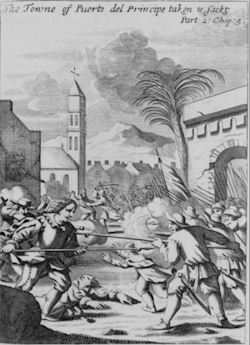 By 1667 relations between England and Spain were deteriorating and Jamaican colonists feared they might be invaded. To counter the threat, Morgan was appointed admiral of a privateer fleet, although he often acted more like an army general, his ships mainly being used to transport the men to attack Spanish settlements. In January 1668, he had assembled a force of twelve ships and about 800 men, including many French buccaneers from Tortuga. Although Morgan only had permission to attack Spanish ships in defence of Jamaica, he presumed to attack targets on the Cuban mainland, reasoning that these places could be used as a base of attack on Jamaica. At first, he intended to attack Havana, but found it too heavily defended, so he decided on Puerto del Principe instead. Unfortunately for the buccaneers, a Spanish captive overheard the plan and managed to escape, thus being able to warn the Spanish authorities. Despite ambushes set by Spanish forces, Morgan successfully ransomed the town for 1000 cattle. The privateers were disappointed with obtaining far less loot than they had expected, and a dispute broke out between English and French buccaneers after an Englishman had stabbed one of his French brothers-in-arms. Although Morgan had the Englishman hanged for the murder many of the French, who constituted half his force, left anyway.
By 1667 relations between England and Spain were deteriorating and Jamaican colonists feared they might be invaded. To counter the threat, Morgan was appointed admiral of a privateer fleet, although he often acted more like an army general, his ships mainly being used to transport the men to attack Spanish settlements. In January 1668, he had assembled a force of twelve ships and about 800 men, including many French buccaneers from Tortuga. Although Morgan only had permission to attack Spanish ships in defence of Jamaica, he presumed to attack targets on the Cuban mainland, reasoning that these places could be used as a base of attack on Jamaica. At first, he intended to attack Havana, but found it too heavily defended, so he decided on Puerto del Principe instead. Unfortunately for the buccaneers, a Spanish captive overheard the plan and managed to escape, thus being able to warn the Spanish authorities. Despite ambushes set by Spanish forces, Morgan successfully ransomed the town for 1000 cattle. The privateers were disappointed with obtaining far less loot than they had expected, and a dispute broke out between English and French buccaneers after an Englishman had stabbed one of his French brothers-in-arms. Although Morgan had the Englishman hanged for the murder many of the French, who constituted half his force, left anyway.
The raid on Porto Bello
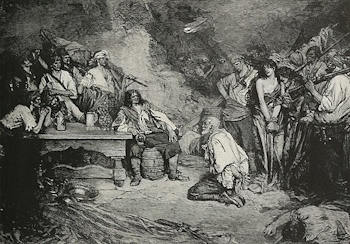 Next, Morgan decided to attack Porto Bello, one of the main trading ports in New Spain. His diminished force of ten ships and 500 men arrived there on 11th July 1668. It was heavily defended by three forts, the first two being taken with the loss of eighteen dead and thirty-two wounded after his men landed in canoes. The third fort, which was defended by the governor himself, offered more resistance. It is claimed by Alexander Exquemelin, who was part of the expedition, that Morgan used nuns and priests as human shields to carry the ladders while scaling the wall, although this didn’t deter the governor from firing on them. The governor refused quarter and was killed in the fighting. After capturing the settlement, the privateers spent a month or two there, during which numerous claims of torture, in order to find the whereabouts of hidden treasure, and rape were made. Morgan ransomed the city, sending demands to the president of Panama, Don Agustín, who refused to pay, instead sending a relief force of 800 men. Morgan ambushed them and drove them away, finally receiving a ransom payment of 100,000 pesos. He then returned to Jamaica, where he enjoyed the good life for a while. Governor Modyford, while pleased with his own share of the loot, reported to the government of England that he had severely reprimanded Morgan for overstepping the mark. Meanwhile, the Spanish commenced raiding on English shipping in retaliation, which increased pressure on a divided English government to put and end to their own privateer raids.
Next, Morgan decided to attack Porto Bello, one of the main trading ports in New Spain. His diminished force of ten ships and 500 men arrived there on 11th July 1668. It was heavily defended by three forts, the first two being taken with the loss of eighteen dead and thirty-two wounded after his men landed in canoes. The third fort, which was defended by the governor himself, offered more resistance. It is claimed by Alexander Exquemelin, who was part of the expedition, that Morgan used nuns and priests as human shields to carry the ladders while scaling the wall, although this didn’t deter the governor from firing on them. The governor refused quarter and was killed in the fighting. After capturing the settlement, the privateers spent a month or two there, during which numerous claims of torture, in order to find the whereabouts of hidden treasure, and rape were made. Morgan ransomed the city, sending demands to the president of Panama, Don Agustín, who refused to pay, instead sending a relief force of 800 men. Morgan ambushed them and drove them away, finally receiving a ransom payment of 100,000 pesos. He then returned to Jamaica, where he enjoyed the good life for a while. Governor Modyford, while pleased with his own share of the loot, reported to the government of England that he had severely reprimanded Morgan for overstepping the mark. Meanwhile, the Spanish commenced raiding on English shipping in retaliation, which increased pressure on a divided English government to put and end to their own privateer raids.
The raid on Maracaibo
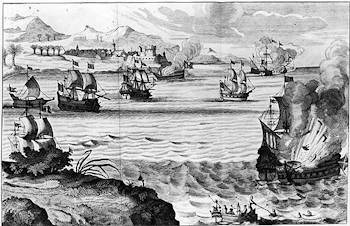 In October 1668, Morgan set up base on the island Île-à-Vache off the coast of Hispaniola with a force of 800 men. He planned to attack Cartagena on the north coast of south America the following year. He was given a 26-gun naval frigate called Oxford to strengthen his fleet, but it unfortunately blew up after a spark ignited the powder magazine, killing 200 of his men and destroying two French prizes. Morgan was one of only six who escaped unscathed, being blown off the ship into the sea below. After that disaster, he then gave up his plan to attack Cartagena, fearing his fleet was now not strong enough. He was later convinced by a French captain to attack Maracaibo instead, just as the French pirate François l’Olonnais had done two years previously. Morgan’s expedition captured the undermanned San Carlos de la Barra fort, which guarded the narrow channel leading to the city. An attempt to blow up the fort by the fleeing Spanish failed. The buccaneers then discovered the town of Maracaibo had been abandoned. After sacking the town and torturing any inhabitants they found hiding nearby for three weeks, they sailed into Lake Maracaibo and attacked the town of Gibraltar, which after some initial resistance was abandoned by its inhabitants. Here the buccaneers spent five weeks sacking the town in the same manner as in Maracaibo, taking what loot they could find and stealing a ship before leaving.
In October 1668, Morgan set up base on the island Île-à-Vache off the coast of Hispaniola with a force of 800 men. He planned to attack Cartagena on the north coast of south America the following year. He was given a 26-gun naval frigate called Oxford to strengthen his fleet, but it unfortunately blew up after a spark ignited the powder magazine, killing 200 of his men and destroying two French prizes. Morgan was one of only six who escaped unscathed, being blown off the ship into the sea below. After that disaster, he then gave up his plan to attack Cartagena, fearing his fleet was now not strong enough. He was later convinced by a French captain to attack Maracaibo instead, just as the French pirate François l’Olonnais had done two years previously. Morgan’s expedition captured the undermanned San Carlos de la Barra fort, which guarded the narrow channel leading to the city. An attempt to blow up the fort by the fleeing Spanish failed. The buccaneers then discovered the town of Maracaibo had been abandoned. After sacking the town and torturing any inhabitants they found hiding nearby for three weeks, they sailed into Lake Maracaibo and attacked the town of Gibraltar, which after some initial resistance was abandoned by its inhabitants. Here the buccaneers spent five weeks sacking the town in the same manner as in Maracaibo, taking what loot they could find and stealing a ship before leaving.
At some point, the buccaneers became aware that three Spanish warships had arrived and were now blockading the narrow strait between the lake and the sea. At first, Morgan tried to negotiate with the commander of the Spanish ship, Vice-Admiral Don Alonso del Campo y Espinosa, who declared he would only let them leave if they left their booty and prisoners behind. In response, Morgan turned the stolen vessel into a fireship, which was made to look like a normal ship crewed by wooden dummies disguised as sailors, sending it directly towards the Spanish ships. The Spanish discovered the ruse too late and their flagship, Magdalena, was set ablaze. Espinosa narrowly escaped the burning vessel before it exploded. The Spanish scuttled the San Luis after it ran aground to prevent it falling into the hands of the buccaneers. The third vessel, Marquesa, was boarded and captured after a short fight. Meanwhile, the admiral and the rest of his men had occupied the fort which guarded the entrance to the lake and there was no way Morgan’s ships could leave without passing in range of the fort’s cannons. Morgan threatened to raze Maracaibo if Espinosa didn’t grant the buccaneers safe conduct, but when Espinosa refused to negotiate this, the inhabitants of the town paid the buccaneers off with 20,000 pesos and 500 head of cattle. Pleased with their accumulated plunder, the buccaneers launched a feigned attack on the landward side of the fort, which tricked the Spaniards into moving their guns to the that side thus allowing Morgan’s ships to pass unmolested. Morgan gave a mocking salute of the guns as they sailed by. Unfortunately for Morgan, when he returned to Port Royal, he discovered that the political climate had changed and his actions were now frowned upon the English monarch Charles II.
The infamous raid on Panama
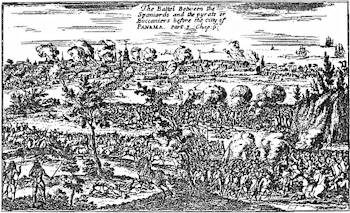 As a result of the attack on Maracaibo, the Spanish Crown ordered attacks on English shipping by privateers of their own. Modyford then gave Morgan a commission to “to do and perform all manner of exploits, which may tend to the preservation and quiet of this island [of Jamaica].” Morgan assembled a force of thirty ships and as many as 2000 men of various nationalities to attack Panama, which they did in December 1670. Firstly, they captured the islands of Old Providence and Santa Catalina, also securing Fort San Lorenzo on the Chagres river as a base for landing and to protect their rear. Then the buccaneers marched across the isthmus. They travelled lightly without sufficient supplies so they could move much faster, although a great deal of the route consisted of swamps and thick rainforest, which hampered their progress. The privateers’ attempts to supply themselves by plundering and living off the land weren’t very successful, because the Spanish had emptied or burnt all the stores along the way, forcing the buccaneers to even resort to eating old leather. Fortunately for Morgan, his men met little resistance as they marched on, the Spanish usually fleeing on sighting the buccaneer force, although they were constantly harassed by indigenous archers. After a 7-day trek, covering part of the route in canoes, the buccaneers finally found food in the form of cattle when they reached the Pacific coast just before reaching Panama itself.
As a result of the attack on Maracaibo, the Spanish Crown ordered attacks on English shipping by privateers of their own. Modyford then gave Morgan a commission to “to do and perform all manner of exploits, which may tend to the preservation and quiet of this island [of Jamaica].” Morgan assembled a force of thirty ships and as many as 2000 men of various nationalities to attack Panama, which they did in December 1670. Firstly, they captured the islands of Old Providence and Santa Catalina, also securing Fort San Lorenzo on the Chagres river as a base for landing and to protect their rear. Then the buccaneers marched across the isthmus. They travelled lightly without sufficient supplies so they could move much faster, although a great deal of the route consisted of swamps and thick rainforest, which hampered their progress. The privateers’ attempts to supply themselves by plundering and living off the land weren’t very successful, because the Spanish had emptied or burnt all the stores along the way, forcing the buccaneers to even resort to eating old leather. Fortunately for Morgan, his men met little resistance as they marched on, the Spanish usually fleeing on sighting the buccaneer force, although they were constantly harassed by indigenous archers. After a 7-day trek, covering part of the route in canoes, the buccaneers finally found food in the form of cattle when they reached the Pacific coast just before reaching Panama itself.
On arrival, Morgan found that a Spanish force of 1200 infantry and 400 cavalry had fortified themselves on a hill before the town. Although it might sound impressive, this force mainly consisted of untrained, poorly equipped townsfolk and slaves with the few firearms they possessed being outdated. The actual attack began on 27th January 1671. At one point in the melee the Spanish thought that Morgan’s men were retreating and sent their cavalry after them, but the buccaneers fended off the Spanish cavalry by forming squares and driving them away. The Spanish could do little to counter the superior firepower of the privateers. At another point in the battle the Spanish herded cattle towards the buccaneers in the hope they would stampede through their ranks of the attackers, but the buccaneers managed to pick off of the herders, driving the cattle back towards the Spanish lines. When the fighting was over the Spanish had lost between 400 and 500 men, against fifteen privateers killed. After the defeat, Governor Juan Perez de Guzman set fire to the town in an attempt to deprive the buccaneers of plunder. The buccaneers did manage to find some treasure, which amounted to between from 140,000 to 400,000 pesos in the ruins. There were allegations that some of the townsfolk were tortured in order to force them to reveal the whereabout of more treasure, but most of it had already be taken away on Spanish vessels before the attack. After their resounding victory, the men got too drunk to capture any of the vessels that were escaping with the treasure, although Morgan had expressly forbid the consumption of alcohol during the expedition. It is claimed there was general discontent at the relatively low amount of loot that was shared among 1500 men and there were even accusations, particularly in Exquemelin’s memoirs, that Morgan left with the majority of the plunder, but there is no evidence to support this. The buccaneers spent three weeks in Panama before the expedition split up on learning they no longer had a commission. Morgan returned to Jamaica, arriving back there on 12th March 1671, although some of his men decided to turn to piracy.
Morgan’s arrest
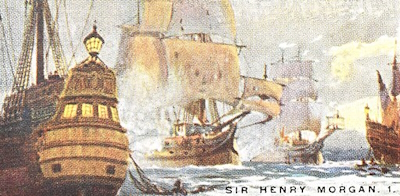 On returning to Jamaica, Morgan found that Thomas Lynch, who strongly opposed buccaneering, had replaced Modyford as governor. Additionally, the Treaty of Madrid had been signed in July 1670, officially ending the war in the Americas. The attack on Panama occured just after the signing of the treaty, which might have led to a renewal of the war if the Spanish weren’t appeased. Things didn’t look too bright for Morgan as he also ill with fever. A few days after his arrival, Lynch ordered that both Morgan together with Modyford, whose removal as governor might have been a condition of the peace treaty, were arrested and sent back to England. After a difficult voyage, the two prisoners arrived in London on 1st April 1672, where Morgan was greeted as a hero by the masses, who were overcome with anti-Catholic sentiment at the time. Fortunately for him, Morgan wasn’t imprisoned in the Tower of London as might have been expected, which would have been detrimental to his health. He seems to have remained at liberty enabling him to bolster support and eventually gain the ear of King Charles II. Morgan was acquitted of any wrong-doing, claiming in his defence that he had been unaware of the treaty at the time of the attack on Panama. He was even knighted in 1674 and made lieutenant-governor of Jamaica. The general consensus was that Henry Morgan and privateering were deemed necessary to defend Jamaica from Spanish aggression.
On returning to Jamaica, Morgan found that Thomas Lynch, who strongly opposed buccaneering, had replaced Modyford as governor. Additionally, the Treaty of Madrid had been signed in July 1670, officially ending the war in the Americas. The attack on Panama occured just after the signing of the treaty, which might have led to a renewal of the war if the Spanish weren’t appeased. Things didn’t look too bright for Morgan as he also ill with fever. A few days after his arrival, Lynch ordered that both Morgan together with Modyford, whose removal as governor might have been a condition of the peace treaty, were arrested and sent back to England. After a difficult voyage, the two prisoners arrived in London on 1st April 1672, where Morgan was greeted as a hero by the masses, who were overcome with anti-Catholic sentiment at the time. Fortunately for him, Morgan wasn’t imprisoned in the Tower of London as might have been expected, which would have been detrimental to his health. He seems to have remained at liberty enabling him to bolster support and eventually gain the ear of King Charles II. Morgan was acquitted of any wrong-doing, claiming in his defence that he had been unaware of the treaty at the time of the attack on Panama. He was even knighted in 1674 and made lieutenant-governor of Jamaica. The general consensus was that Henry Morgan and privateering were deemed necessary to defend Jamaica from Spanish aggression.
Morgan becomes Lieutenant Governor of Jamaica
Morgan left for Jamaica in 1675 on board the Jamaica Merchant carrying a number of cannons to fortify Port Royal’s defences. Unfortunately, the ship was wrecked on the rocks off Île-à-Vache, Morgan and his crew being temporarily stranded on the island until picked up by a passing merchant ship. Morgan eventually reached Jamaica, now as lieutenant governor with an annual salary of £600. In his new position, Morgan had the fortifications rebuilt as well as reviving the militia. He later fell into bouts of drinking and gambling, making him unpopular with Vaughan, who believed Morgan to be unsuitable for the post, trying his best to have him removed from his post, although he failed in his efforts because Morgan was far too popular on Jamaica. Eventually, Vaughan was replaced as governor by Charles Howard, 1st Earl of Carlisle, who soon befriended Morgan. Although he clamped down on piracy, Morgan was more lenient where privateers against the Spanish were concerned, he himself greatly profiting from their raiding. Not being allowed to issue privateering commissions himself, Morgan is believed to have received payment for every privateer vessel he referred to the French governor of Tortuga. The French governor there had less reservations about attacking not only Spanish but also Dutch assets as France was at war with the Dutch from 1672 to 1678. About 1200 privateers were believed to have been operating there at the time. Morgan was made acting governor of the island from 1678 to 1680 when the French were posing the largest threat in the Caribbean. During this time he heavily fortified Jamaica. Additionally, Morgan was a slave holder, leading campaigns against the Jamaican maroons with some success, driving them further into the Blue Mountains.
Accusations against Morgan
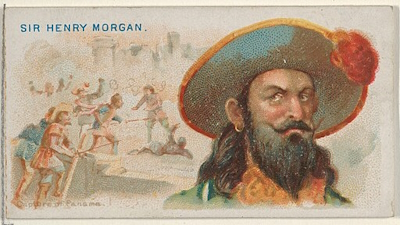 A national hero in England, Morgan was viewed as a notorious pirate by the Spanish to the extent that Francis Drake was, possibly even giving him the same nickname of El Draque. Morgan didn’t regard himself of having done anything wrong, instead presenting himself the protector of Jamaica. In 1684, he brought a libel suit against the English publishers of Exquemelin’s book The Buccaneers of America, in which it was claimed that Morgan committed many atrocities: using monks and nuns as a human shield; torturing prisoners; raping a female prisoner; setting fire to Panama; keeping the Panama loot for himself, to name but a few. Although some atrocities were indeed committed by the unruly bunch of buccaneers he led, there is no evidence these acts were carried out on his command. Most of the accusations were disproved by various eyewitness accounts and Morgan won the court case in England, either because the stories were lies or Morgan had powerful friends. The English version had to be retracted and he was award £200 damages. It seems that Exquemelin might have made up at least some of the stories, either for dramatic effect or because he held a grudge against Morgan, but by slandering the buccaneer leader the author inadvertently helped make him and his deeds famous.
A national hero in England, Morgan was viewed as a notorious pirate by the Spanish to the extent that Francis Drake was, possibly even giving him the same nickname of El Draque. Morgan didn’t regard himself of having done anything wrong, instead presenting himself the protector of Jamaica. In 1684, he brought a libel suit against the English publishers of Exquemelin’s book The Buccaneers of America, in which it was claimed that Morgan committed many atrocities: using monks and nuns as a human shield; torturing prisoners; raping a female prisoner; setting fire to Panama; keeping the Panama loot for himself, to name but a few. Although some atrocities were indeed committed by the unruly bunch of buccaneers he led, there is no evidence these acts were carried out on his command. Most of the accusations were disproved by various eyewitness accounts and Morgan won the court case in England, either because the stories were lies or Morgan had powerful friends. The English version had to be retracted and he was award £200 damages. It seems that Exquemelin might have made up at least some of the stories, either for dramatic effect or because he held a grudge against Morgan, but by slandering the buccaneer leader the author inadvertently helped make him and his deeds famous.
Morgan’s end
This successful buccaneer from a well-to-do background ended his days on Jamaica after a hard career. Due to the plotting of ex-governors Lynch and Vaughan, he was eventually removed from his position as lieutenant governor, although by this time he had managed to become very wealthy and influential. His days were filled with drinking, smoking, and gambling. In December 1687, his old friend Christopher Monck, 2nd Duke of Albemarle was appointed as governor and Morgan hoped to be reinstated. In early 1688, Morgan became ill with dropsy, an unpleasant swelling of the extremities, but despite his illness he continued to drink heavily. He was eventually reinstated to the governing council in July of the same year, although he was by then in poor health and needed the aid of a cane to walk. After a spectacular career Morgan died an unspectacular death on 25th August 1688 at the age of 53, leaving his fortune of over £5000, three plantations, and 131 slaves to his wife. For his funeral, an amnesty was declared so that pirates and privateers could pay their respects without fear of arrest. He was buried at Palisadoes cemetery, Port Royal, to a 22-gun salute from the ships in the harbour. His remains were lost during the Earthquake of 1692.
For more on Henry Morgan watch the informative video below by Gold and Gun Powder.
